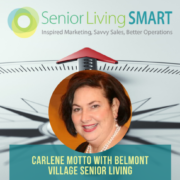Senior Living Marketing Perspectives: Best Practices around Marketing and Communication Strategy Used by Various Industries Amid the Covid-19 Pandemic
Topics Discussed and Key Points:
- What direction should marketing and communications take amid COVID-19?
- The power of “sharing, not selling” as a long-term approach to business development
- Why your organization should shift from crisis communication to resource communication
- How to get people comfortable about potentially moving into a senior living community during a pandemic
- What can we learn from this situation, marketing and communications-wise, to become better prepared should another crisis hit?
Episode Summary:
In today’s episode, Debbie speaks with Dan Hutson, Marketing and Communications consultant. The pair discuss best practices around marketing and communication strategy used by various industries amid the COVID-19 pandemic, and how these practices can be implemented by the senior housing industry.
Today, organizations have to choose between quietly waiting out the crisis, and looking for opportunities to innovate. Much of the senior living world has chosen the former strategy. Worse than that, some even chose to do “tone-deaf” marketing that completely ignores the new normal. Consumers and clients are more forgiving towards vulnerability and more “raw” messaging, as long as the company can assure them, with a level head, that they are willing and able to consistently follow through in spite of current challenges.
“This situation has freed up your time from doing a lot of the business-as-usual marketing work,” says Dan. “Take this time to really think about interesting ways of connecting with your audience—communicating and creating ongoing conversations with them.” If more organizations adopt this paradigm, there may endure, long after the end of this crisis, a “sharing, not selling” approach to business.
It helps greatly to put yourself in the shoes of those you’re trying to serve. Imagine what a typical member of your target audience is thinking, feeling, and doing at this very moment. One thing’s for sure: there’s so much uncertainty in the world today that people in general are just looking for leaders to help make their struggles more bearable. This, says Dan, becomes the perfect opportunity to serve as your customer’s go-between—to position your company as an incredible resource which provides useful services outside the usual scope of your business.
At a time when social distancing is the norm, ask yourself how you’re adopting technology to support your sales and marketing effort. If you want more people to become comfortable with the idea of potentially moving into a senior living community, particularly during this pandemic, digital and inbound marketing should be your priorities. Many people are uninformed about the different types of available communities, not to mention their concerns about sanitation in these spaces.
If relevance is what you’re after, there’s no better time than this moment to put out regular content that tells your customers exactly what services they should be expecting from your organization. This content should illustrate the reality of your senior living space as a “living, breathing community of people who are engaged in interesting, purposeful lives.”




